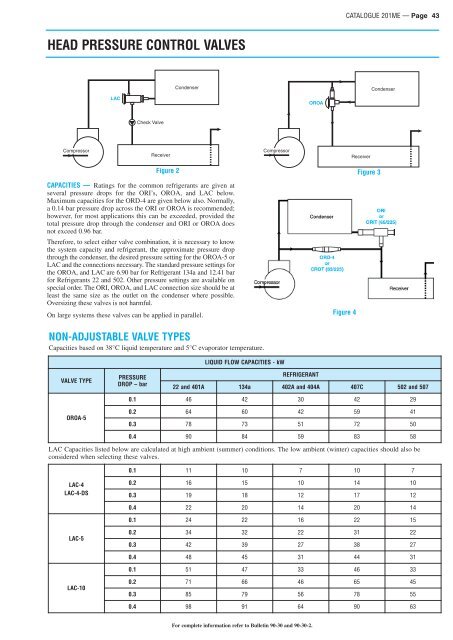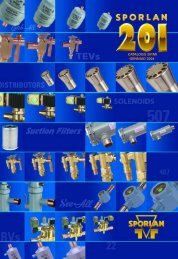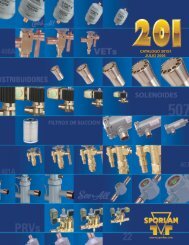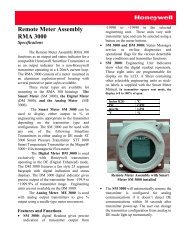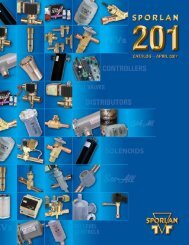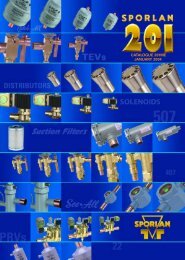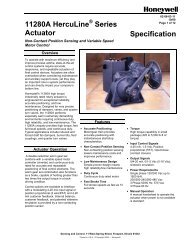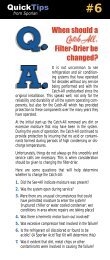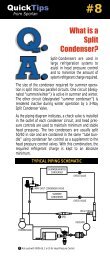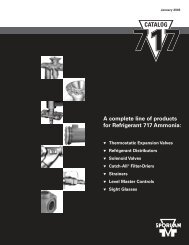CATALOGUE 201ME JANUARY 2004
CATALOGUE 201ME JANUARY 2004
CATALOGUE 201ME JANUARY 2004
You also want an ePaper? Increase the reach of your titles
YUMPU automatically turns print PDFs into web optimized ePapers that Google loves.
<strong>CATALOGUE</strong> <strong>201ME</strong> — Page 43<br />
HEAD PRESSURE CONTROL VALVES<br />
Condenser<br />
Condenser<br />
LAC<br />
OROA<br />
Check Valve<br />
Compressor<br />
Receiver<br />
Compressor<br />
Receiver<br />
Figure 2 Figure 3<br />
CAPACITIES — Ratings for the common refrigerants are given at<br />
several pressure drops for the ORI’s, OROA, and LAC below.<br />
Maximum capacities for the ORD-4 are given below also. Normally,<br />
a 0.14 bar pressure drop across the ORI or OROA is recommended;<br />
however, for most applications this can be exceeded, provided the<br />
total pressure drop through the condenser and ORI or OROA does<br />
not exceed 0.96 bar.<br />
Therefore, to select either valve combination, it is necessary to know<br />
the system capacity and refrigerant, the approximate pressure drop<br />
through the condenser, the desired pressure setting for the OROA-5 or<br />
LAC and the connections necessary. The standard pressure settings for<br />
the OROA, and LAC are 6.90 bar for Refrigerant 134a and 12.41 bar<br />
for Refrigerants 22 and 502. Other pressure settings are available on<br />
special order. The ORI, OROA, and LAC connection size should be at<br />
least the same size as the outlet on the condenser where possible.<br />
Oversizing these valves is not harmful.<br />
On large systems these valves can be applied in parallel.<br />
Figure 4<br />
NON-ADJUSTABLE VALVE TYPES<br />
Capacities based on 38°C liquid temperature and 5°C evaporator temperature.<br />
LIQUID FLOW CAPACITIES - kW<br />
VALVE TYPE<br />
PRESSURE<br />
DROP<br />
– bar<br />
REFRIGERANT<br />
22<br />
and 401A<br />
134a<br />
402A<br />
and 404A<br />
407C<br />
502 and 507<br />
0.1<br />
46<br />
42<br />
30<br />
42<br />
29<br />
OROA-5<br />
0.2<br />
64<br />
60<br />
42<br />
59<br />
41<br />
0.3<br />
78<br />
73<br />
51<br />
72<br />
50<br />
0.4<br />
90<br />
84<br />
59<br />
83<br />
58<br />
LAC Capacities listed below are calculated at high ambient (summer) conditions. The low ambient (winter) capacities should also be<br />
considered when selecting these valves.<br />
0.1<br />
11<br />
10<br />
7 10<br />
7<br />
LAC-4<br />
LAC-4-DS<br />
0.2<br />
16<br />
15<br />
10<br />
14<br />
10<br />
0.3<br />
19<br />
18<br />
12<br />
17<br />
12<br />
0.4<br />
22<br />
20<br />
14<br />
20<br />
14<br />
0.1<br />
24<br />
22<br />
16<br />
22<br />
15<br />
LAC-5<br />
0.2<br />
34<br />
32<br />
22<br />
31<br />
22<br />
0.3<br />
42<br />
39<br />
27<br />
38<br />
27<br />
0.4<br />
48<br />
45<br />
31<br />
44<br />
31<br />
0.1<br />
51<br />
47<br />
33<br />
46<br />
33<br />
LAC-10<br />
0.2<br />
71<br />
66<br />
46<br />
65<br />
45<br />
0.3<br />
85<br />
79<br />
56<br />
78<br />
55<br />
0.4<br />
98<br />
91<br />
64<br />
90<br />
63<br />
For complete information refer to Bulletin 90-30 and 90-30-2.


